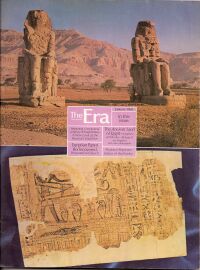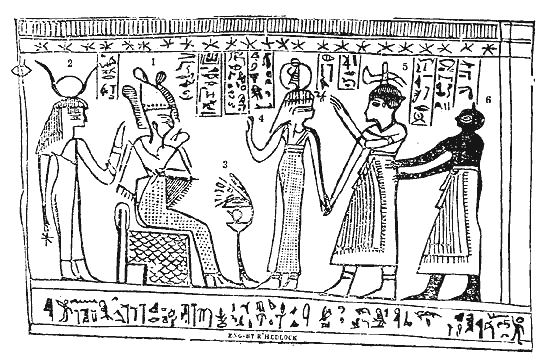
FAIR is a non-profit organization dedicated to providing well-documented answers to criticisms of the doctrine, practice, and history of The Church of Jesus Christ of Latter-day Saints.
This article is a draft. FairMormon editors are currently editing it. We welcome your suggestions on improving the content.
| Answers portal |
| The Book of Abraham |
 |
|
FAQ:
Book of Abraham content: Production: |
|
A variety of criticisms are associated with Facsimile 3:
To see citations to the critical sources for these claims, click here
The final illustration (view) is of the justified and exalted Hor (figure 5) being introduced by the Egyptian gods Ma'at (4) and Anubis (6) to the god Osiris (1) in the afterlife. Isis (2), Osiris' sister/wife, is also present. Their names are indicated by the Egyptian characters above their heads.[1]
Joseph Smith's notes to Facsimile 3 identify the illustration as representing "Abraham sitting upon Pharaoh's throne" (note to figure 1), an event foreshadowed in the text of the Book of Abraham (Abr 2꞉21-25), but not described in any existing translation produced by Joseph.

Robert K. Ritner, Professor of Egyptology at the University of Chicago, states that "Smith’s hopeless translation also turns the goddess Maat into a male prince, the papyrus owner into a waiter, and the black jackal Anubis into a Negro slave."[2]
Larry E. Morris notes the following in response to criticism leveled by Ritner at the Book of Abraham,
Furthermore, Ritner does not inform his readers that certain elements of the Book of Abraham also appear in ancient or medieval texts. Take, for example, Facsimile 3, which depicts, as Ritner puts it, "enthroned Abraham lecturing the male Pharaoh (actually enthroned Osiris with the female Isis)" (JNES, p. 162). In what Ritner describes as nonsense, Joseph Smith claimed that Abraham is "sitting upon Pharoah's throne . . . reasoning upon the principles of Astronomy" (Facsimile 3, explanation).
Clearly, Joseph Smith's interpretation did not come from Genesis (where there is no discussion of Abraham doing such a thing). From Ritner's point of view, therefore, this must qualify as one of Joseph's "uninspired fantasies." But going a layer deeper reveals interesting complexities. A number of ancient texts, for example, state that Abraham taught astronomy to the Egyptians. Citing the Jewish writer Artapanus (who lived prior to the first century BC), a fourth-century bishop of Caesarea, Eusebius, states: "They were called Hebrews after Abraham. [Artapanus] says that the latter came to Egypt with all his household to the Egyptian king Pharethothes, and taught him astrology, that he remained there twenty years and then departed again for the regions of Syria."22
As for Abraham sitting on a king's throne—another detail not mentioned in Genesis—note this example from Qisas al-Anbiya' (Stories of the Prophets), an Islamic text compiled in AD 1310: "The chamberlain brought Abraham to the king. The king looked at Abraham; he was good looking and handsome. The king honoured Abraham and seated him at his side."23 [3]
Morris concludes,
Ritner may counter that such parallels do not establish the authenticity of the Book of Abraham. That is true, but certainly they deserve some mention. At the very least, these parallels show that "all of this nonsense" is not really an appropriate description of Joseph Smith's interpretation. Fairness demands that Ritner, in his dismissal of the content of the Book of Abraham, at least mention similarities between it and other texts about Abraham and point readers to other sources of information. [4]
"the Qisas includes an account of Abraham being seated next to a king." [5]
For a detailed response, see: Book of Abraham/Parallels with ancients texts
Critics focus on three specific interpretations which reference an interpretation of characters in the facsimile. Joseph Smith provides the following identifications for three of the figures in the facsimile:
What is notable in these particular identifications is that Joseph isn't simply assigning an identify to each figure, but is indicating that characters located near each figure confirm the assignments. Egyptologists, note that the characters have an entirely different meaning.

FAIR is a non-profit organization dedicated to providing well-documented answers to criticisms of the doctrine, practice, and history of The Church of Jesus Christ of Latter-day Saints.
We are a volunteer organization. We invite you to give back.
Donate Now